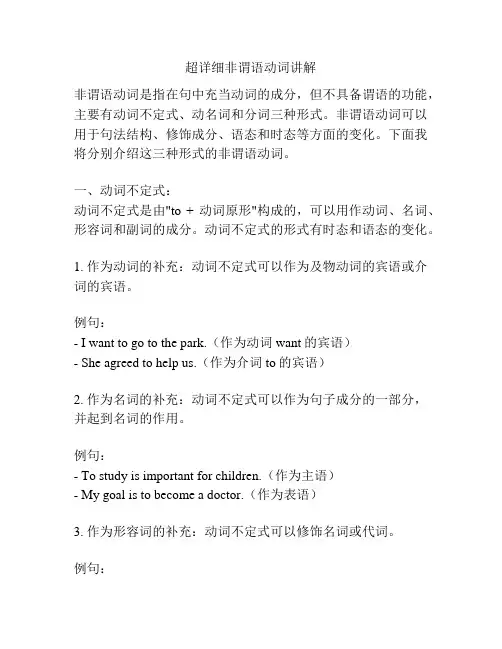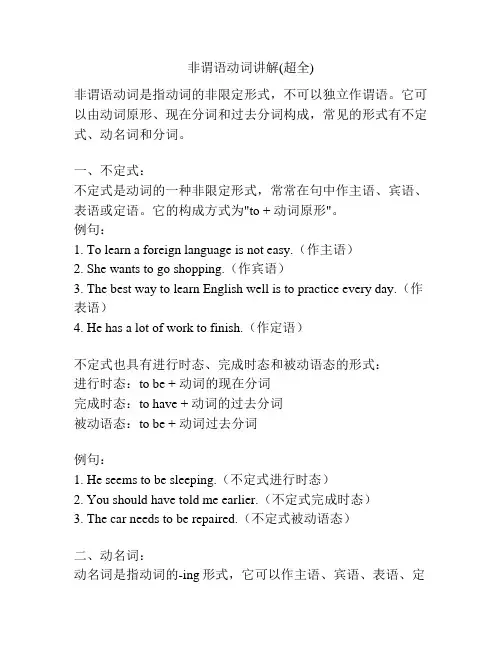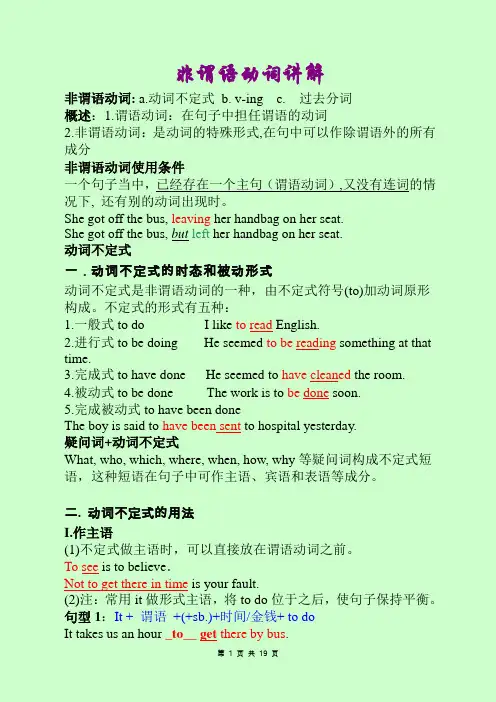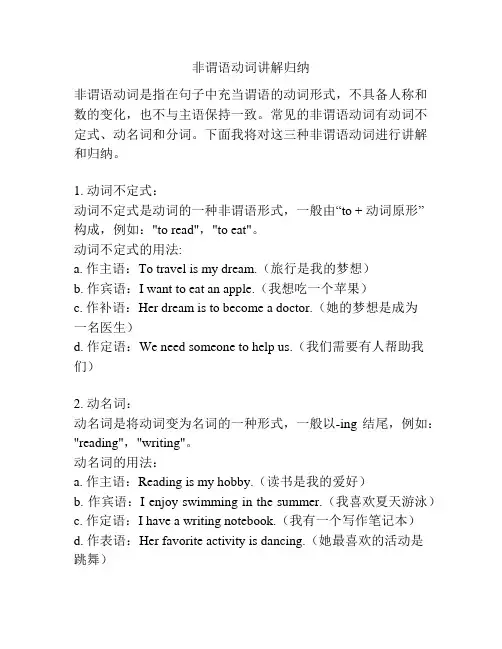超详细非谓语动词讲解
超详细非谓语动词讲解

超详细非谓语动词讲解非谓语动词是指在句中充当动词的成分,但不具备谓语的功能,主要有动词不定式、动名词和分词三种形式。
非谓语动词可以用于句法结构、修饰成分、语态和时态等方面的变化。
下面我将分别介绍这三种形式的非谓语动词。
一、动词不定式:动词不定式是由"to + 动词原形"构成的,可以用作动词、名词、形容词和副词的成分。
动词不定式的形式有时态和语态的变化。
1. 作为动词的补充:动词不定式可以作为及物动词的宾语或介词的宾语。
例句:- I want to go to the park.(作为动词want的宾语)- She agreed to help us.(作为介词to的宾语)2. 作为名词的补充:动词不定式可以作为句子成分的一部分,并起到名词的作用。
例句:- To study is important for children.(作为主语)- My goal is to become a doctor.(作为表语)3. 作为形容词的补充:动词不定式可以修饰名词或代词。
例句:- I have a book to read.(修饰名词book)- She needs someone to help her.(修饰代词someone)4. 作为副词的补充:动词不定式可以修饰动词、形容词或副词。
例句:- He came here to visit his parents.(修饰动词came)- The coffee is too hot to drink.(修饰形容词hot)二、动名词:动名词是由动词的现在分词形式构成的名词,具有名词的特点,可以作为主语、宾语、表语、定语和同位语等。
1. 作为主语:动名词可以作为句子的主语。
例句:- Dancing is her favorite hobby.2. 作为宾语:动名词可以作为及物动词的宾语。
例句:- He enjoys swimming in the sea.3. 作为表语:动名词可以作为系动词的表语。
非谓语动词讲解(超全)

非谓语动词讲解(超全)非谓语动词是指动词的非限定形式,不可以独立作谓语。
它可以由动词原形、现在分词和过去分词构成,常见的形式有不定式、动名词和分词。
一、不定式:不定式是动词的一种非限定形式,常常在句中作主语、宾语、表语或定语。
它的构成方式为"to + 动词原形"。
例句:1. To learn a foreign language is not easy.(作主语)2. She wants to go shopping.(作宾语)3. The best way to learn English well is to practice every day.(作表语)4. He has a lot of work to finish.(作定语)不定式也具有进行时态、完成时态和被动语态的形式:进行时态:to be + 动词的现在分词完成时态:to have + 动词的过去分词被动语态:to be + 动词过去分词例句:1. He seems to be sleeping.(不定式进行时态)2. You should have told me earlier.(不定式完成时态)3. The car needs to be repaired.(不定式被动语态)二、动名词:动名词是指动词的-ing形式,它可以作主语、宾语、表语、定语或状语。
在句中的位置和用法与名词相似。
例句:1. Reading is my favorite hobby.(作主语)2. I enjoy swimming in the summer.(作宾语)3. Her dream is becoming a famous singer.(作表语)4. The girl standing over there is my sister.(作定语)5. He went to the party without saying goodbye.(作状语)动名词与不定式的区别在于动名词具有进行时态和被动语态,而不定式没有。
非谓语动词讲解(超全超实用)

非谓语动词讲解非谓语动词: a.动词不定式 b. v-ing c. 过去分词概述:1.谓语动词:在句子中担任谓语的动词2.非谓语动词:是动词的特殊形式,在句中可以作除谓语外的所有成分非谓语动词使用条件一个句子当中,已经存在一个主句(谓语动词),又没有连词的情况下, 还有别的动词出现时。
She got off the bus, leaving her handbag on her seat.She got off the bus, but left her handbag on her seat.动词不定式一.动词不定式的时态和被动形式动词不定式是非谓语动词的一种,由不定式符号(to)加动词原形构成。
不定式的形式有五种:1.一般式to do I like to read English.2.进行式to be doing He seemed to be reading something at that time.3.完成式to have done He seemed to have cleaned the room.4.被动式to be done The work is to be done soon.5.完成被动式to have been doneThe boy is said to have been sent to hospital yesterday.疑问词+动词不定式What, who, which, where, when, how, why等疑问词构成不定式短语,这种短语在句子中可作主语、宾语和表语等成分。
二. 动词不定式的用法I.作主语(1)不定式做主语时,可以直接放在谓语动词之前。
To see is to believe.Not to get there in time is your fault.(2)注:常用it做形式主语,将to do位于之后,使句子保持平衡。
句型1:It + 谓语+(+sb.)+时间/金钱+ to doIt takes us an hour _to__ get there by bus.It costs you only $ 100 a month to cook at home.It seemed impossible to save money.句型2:I t’s + n. (+ for sb) + to doIt’s our duty _to_ help the poor.It is a great enjoyment _to_ spend our holiday in the countryside..It is a great honor for us to be present at your birthday party.句型3:It is + adj (+ for sb)to do sth(是形容事物的性质的)It is + adj (+ of sb)to do sth(是形容人的品质的)It is easy for me to finish this work before ten.It is very kind of you to give me some help.It's impolite of you to speak to the teacher like that.疑问词+不定式作主语When to start remains undecided.1.It is easy to get there by bus or taxi.2. It takes about 3 hours to see all the birds.3. It is also impolite to speak with your mouth full when you are eating.4. It’s our duty to take good care of the old.5. How long did it take you to finish the work?6. It is stupid of you to write down everything the teacher says.7. When to start has not been decided.8. It seemed selfish of him not to give them anything.9. It’s necessary for you to lock the car when you do not use it.10. It is useful for our health to do morning exercises.II.作宾语接不定式做宾语I want to know this matter.I don’t expect to meet you here(1)常见动词有:like, demand, expect, promise, begin, determine, refuse, fail, manage, learn, seem, forget, want, prepare, pretend, plan, wish等They want to get_( get ) on the bus, didn’t they?He said he wished __to be ( be ) a professor.(2)it作形式宾语I find/feel to work with him interesting .I find/feel it interesting to work with him.Subject+ find/think/feel/make/ consider… it+adj/n + to do sth.1.We thought _it__ better __to_ start early.2.Do you consider _it__ better not _to_ go?3. I feel _it_ my duty _to_ change all that.4.We think it __ important _ to _ obey the law.5.I know _ it _ impossible _ to _ finish so much homework in a day.(3)疑问词+不定式作宾语常常放在这些动词的后面作宾语:tell, advise, show, teach, find out, decide, discuss, learn, explain…He taught us how to use the tool.No one could tell me where to get the book.The dictionary didn’t tell the Frenchman how to pronounce the word.(4) 作介词but, except, besides的宾语。
非谓语动词讲解归纳

非谓语动词讲解归纳非谓语动词是指在句子中充当谓语的动词形式,不具备人称和数的变化,也不与主语保持一致。
常见的非谓语动词有动词不定式、动名词和分词。
下面我将对这三种非谓语动词进行讲解和归纳。
1. 动词不定式:动词不定式是动词的一种非谓语形式,一般由“to + 动词原形”构成,例如:"to read","to eat"。
动词不定式的用法:a. 作主语:To travel is my dream.(旅行是我的梦想)b. 作宾语:I want to eat an apple.(我想吃一个苹果)c. 作补语:Her dream is to become a doctor.(她的梦想是成为一名医生)d. 作定语:We need someone to help us.(我们需要有人帮助我们)2. 动名词:动名词是将动词变为名词的一种形式,一般以-ing结尾,例如:"reading","writing"。
动名词的用法:a. 作主语:Reading is my hobby.(读书是我的爱好)b. 作宾语:I enjoy swimming in the summer.(我喜欢夏天游泳)c. 作定语:I have a writing notebook.(我有一个写作笔记本)d. 作表语:Her favorite activity is dancing.(她最喜欢的活动是跳舞)3. 分词:分词是动词的一种非谓语形式,一般以-ing或-ed结尾,分别称为现在分词和过去分词,例如:"running","cooked"。
分词的用法:a. 现在分词作定语:The running water is very clean.(流动的水很干净)b. 过去分词作定语:The cooked chicken smells delicious.(煮熟的鸡肉闻起来很香)c. 分词作伴随状语:Hearing the news, she smiled happily.(听到消息,她高兴地笑了)需要注意的是,非谓语动词的形式可以有时态和语态的变化,如不定式可以有完成和进行的形式,动名词可以有进行和完成的形式,分词可以有进行、完成和被动的形式。
英语语法非谓语动词讲解超全超实用

英语语法非谓语动词讲解超全超实用在英语语法中,非谓语动词是指在句子中不能独立充当谓语,而是通过与其他词语搭配来发挥作用的动词形式。
非谓语动词包括动词不定式、动名词和分词。
本文将对这三种非谓语动词进行详细的讲解,帮助读者更好地理解和运用。
一、动词不定式1.定义和形式:动词不定式是由动词原形加上"to"构成的形式,表示不完整的动作或状态。
例如:to eat, to dance。
2.用途和功能:(1)作主语:动词不定式可以作为句子的主语,常放在句首。
例如:To learn a new language is challenging.(2)作宾语:动词不定式可以作为及物动词的宾语,表示动作的目的或意图。
例如:I want to learn English.(3)作表语:动词不定式可以作为系动词的表语,表示身份、偏好、目的等。
例如:Her dream is to become a doctor.(4)作定语:动词不定式可以修饰名词或代词,起到进一步说明或限定的作用。
例如:The best way to improve English is to practice more.(5)作状语:动词不定式可以表示时间、目的、方式等状语的作用。
例如:I went to the park to relax.3.特殊用法:(1)省略to:在某些情况下,不定式的to可以省略,例如在助动词let、make、help等后面。
例如:Let me go.(2)动词不定式的时态:动词不定式没有人称和数的变化,但可以根据不同的时间来使用不同的时态。
例如:I want to go shopping.(现在时态)I wanted to go shopping.(过去时态)二、动名词1.定义和形式:动名词是由动词加上-ing构成的形式,可以作为名词使用。
例如:swimming, running。
2.用途和功能:(1)作主语:动名词可以作为句子的主语,常放在句首。
非谓语动词详解(腾飞教育)

非谓语动词主要包括不定式、动名词和现在分词。
为了区分这三种不同的非谓语动词的用法和含义,我们将分别从三种非谓语动词在句子中做主语、宾语、宾语补足语、定语、状语、表语以及一些特殊结构句型等角度来区分其用法和细微含义。
1.不定式和动名词作主语的区别(1)动名词作主语通常表示抽象动作;而不定式作主语表示具体动作。
Smoking is prohibited(禁止)here.这里禁止抽烟。
(抽象)It is not very good for you to smoke so much.你抽这么多烟对你身体很不好。
(具体)(2)动名词作主语时,通常用以表示一件已知的事或经验。
不定式短语通常用来表示一件未完成的事或目的。
Climbing mountains is interesting.爬山很有趣。
(经验)Driving a car during the rush hour is tiring.在高峰时刻开车令人厌烦。
(经验)(3)不定式做主语,一般用it当形式主语,把作主语的不定式短语后置。
It took me only five minutes to finish the job.2.不定式、动名词和分词作表语的区别(1)不定式作表语1)不定式作表语一般表示具体动作,特别是表示将来的动作。
To do two things at a time is to do neither.--次做两件事等于未做。
What I would suggest is to start work at once.我的建议是立刻开始干。
2)如果主语是不定式(表示条件),表语也是不定式(表示结果)。
To see is to believe.百闻不如一见。
To work means to earn a living.工作就是为了生活。
3)如果主语是以aim,duty,hope,idea,happiness,job,plan,problem,purpose,thing,wish等为中心的名词,或以what引导的名词性从句,不定式作表语是对主语起补充说明作用。
非谓语动词超详细讲解ppt课件
动名词既有普通形式,也有完成形式和被动形式。完成形式表示动作已经完成, 如having read;被动形式表示动作被承受,如being written。
动名词在句子中的成分
动名词也可以作表语,用来描述 主语的内容或性质,如Her job is teaching English.
动名词还可以作定语,修饰名词, 如a reading room, a swimming pool等。
非谓语动词超详用法与功能 • 动名词的用法与功能 • 分词的用法与功能 • 独立主格结构的用法与功能 • 非谓语动词的注意事项与误区
01
非谓语动词概述
Chapter
定义与作用
定义
非谓语动词是指在句子中不充当谓 语的动词,包括不定式、动名词和 分词三种形式。
独立主格结构的时态和语态
时态
独立主格结构的时态主要根据句子中的谓语动词来确定。如果谓语动词是现在时或将来 时,独立主格结构用现在分词;如果谓语动词是过去时,独立主格结构用过去分词。
语态
独立主格结构的语态分为主动语态和被动语态。当独立主格结构的逻辑主语与非谓语动 词之间是主动关系时,用主动语态;当逻辑主语与非谓语动词之间是被动关系时,用被 动语态。例如:“The problem being settled, we all felt relieved.”(问题解决了,
我们都感到松了一口气。)
06
非谓语动词的注意事项与误区
Chapter
非谓语动词使用时需要注意的问题
动词不定式、动名词和分词的区别
01
在使用非谓语动词时,需要根据语境和表达的逻辑关系选择适
当的非谓语动词形式。
时态和语态的正确使用
02
非谓语动词用法详细讲解
⾮谓语动词⽤法详细讲解⾮谓语动词⽤法详解动词的⾮谓语形式有三种:不定式、动名词和分词(⼀)不定式不定式由“to⼗动词原形”构成,其否定形式是“not to do ” ?不定式可以带宾语或状语构成不定式短语,没有⼈称和数的变化,但有时态和语态的变化?不定式可作主语、宾语、状语、表语和定语,但不能单独作谓语?不定式的逻辑主语有时⽤“for⼗名词或代词宾格”构成.1 ?不定式的⽤法:1)作主语.不定式短语作主语时,往往放在谓语之后,⽤it作形式主语?例如:To see is to believe .It is right to give up smok ing2)作宾语.不定式短语作宾语时,如果还带有宾语补⾜语。
往往把不定式宾语放在宾语补⾜语之后,⽽⽤it作形式宾语.例如:He wan ted to go .I find it interesting to study work with him.3)作宾语补⾜语.例如:He asked me to do the work with him.注意 :在feel,hear,listen to,look at,notice, observe,see,watch,have, let,make等词后的补⾜语中,不定式不带to.但是这些句⼦如果变成被动结构时,就必须带to.例如I ofte n hear him sing the songHe is ofte n heard to sing the song注意:不定式动词在介词but, except, besides后⾯时,如果这些介词之前有⾏为动词do的各种形式,那么,这些介词后的不定式不带to,否则要带to.⼥⼝:She could do nothing but cry.What do you like to do besides swim?I have no choice but to go .动词help之后,带to或不带to都可以。
(完整版)高中英语非谓语动词详解
第二讲非谓语动词教学重点1,非谓语动词和谓语动词的区别;2,非谓语动词的各种形式和应用;3,非谓语动词的考点解析。
一、非谓语动词与非谓语动词的区别1.谓语动词在句中可单独作谓语,而非谓语动词不能单独作谓语。
如:Miss Mary teaches us English . 玛丽教我们英语。
(teaches是谓语动词。
)Mr Victor came to our classroom to have a talk with us last week.维克托先生上周末来到了我们教室和我们谈话。
(to have a talk不定式作状语)2.谓语动词受主语的人称和数的限制,而非谓语动词形式没有这种限制。
如:Tom likes the pop music. 汤姆喜欢流行音乐。
(动词用第三人称单数形式)Tom has nothing to do today. 汤姆今天没有什么事要做。
(do用原形)二、非谓语动词的各种形式和应用非谓语动词主要包括不定式、动名词和分词。
其动能和形式如下:非谓语动词在句中所做的成分如下:三、考点解析非谓语动词一直是高考中的热点。
解答非谓语动词的题目时,一定要解析句子结构,确定所设空是谓语动词还是非谓语动词,以及非谓语动词在句子中充当的功能(如状语、定语或宾补);找准相关动词的逻辑主语,确定该动词与逻辑主语是什么关系(主动还是被动);搜索句子中相关的时间信息,确定非谓语动词的恰当形式。
1 动名词和不定式作表语①如果表语是不定式,主语也是不定式;表语是动名词,主语也是动名词。
如:To see is to believe.=Seeing is believing.②动名词作主语的句型。
如:It is no use/no good/useless doing sth.It is a waste of time doing(也可用It is a waste of time to do)③动词不定式和动名词的复合结构:动词不定式的复合结构有两种:It is difficult/easy/possible/necessary/...for sb. to do sth.和It is kind/wise/foolish/considerate/...of sb. to do。
非谓语动词讲解(超全
非谓语动词讲解(超全非谓语动词是指动词的非谓语形式,包括动词不定式、动名词和现在分词。
与主谓结构不同,非谓语动词可在句子中作状语、定语或表语。
在英语中,非谓语动词的形式是相对固定的,但在不同的语法环境中所表示的意义和用法有所差异。
1. 动词不定式(to-infinitive)动词不定式由“to + 动词原形”构成,常常用作动词的宾语、主语、状语或定语。
例如:- 宾语:I want to go to the zoo.(我想去动物园。
)- 主语:To speak English fluently is important for your career.(流利地说英语对你的事业很重要。
)- 状语:He went to the store to buy some groceries.(他去商店买了些杂货。
)- 定语:She needs a pen to write her essay.(她需要一支笔来写作文。
)2. 动名词(gerund)动名词是将动词加上-ing构成,常常用作动词的宾语、主语、状语或定语。
例如:- 宾语:I enjoy reading books in my spare time.(我闲暇时喜欢读书。
)- 主语:Swimming is good exercise.(游泳是很好的锻炼。
)- 状语:She left the party early, feeling tired.(她因为感觉累了,所以提前离开了聚会。
)- 定语:The crying baby woke up the whole neighborhood.(哭闹的婴儿把整个邻居都吵醒了。
)3. 现在分词(present participle)现在分词由动词原形加上-ing构成,常常用作动词的宾语、主语、状语或定语。
例如:- 宾语:He enjoys playing soccer on weekends.(他喜欢周末踢足球。
)- 主语:Listening to music helps me relax.(听音乐帮助我放松。
- 1、下载文档前请自行甄别文档内容的完整性,平台不提供额外的编辑、内容补充、找答案等附加服务。
- 2、"仅部分预览"的文档,不可在线预览部分如存在完整性等问题,可反馈申请退款(可完整预览的文档不适用该条件!)。
- 3、如文档侵犯您的权益,请联系客服反馈,我们会尽快为您处理(人工客服工作时间:9:00-18:30)。
专业.专注.非谓语动词(the Non-Finite Verbs )定义在句子中不是谓语的动词,形式:不定式、动名词和分词(现在分词和过去分词) 作用:在句子中充当主语、宾语、状语等。
特点:1.非谓语动词可以有名词作用(如动词不定式和动名词),在句中做主语、宾语、表语。
2. 非谓语动词可以有形容词作用 (如动词不定式和分词),在句中做定语、表语或宾语补足语。
3.非谓语动词可以有副词作用 (如动词不定式和分词),在句中作状语。
4.谓语动词在句中作谓语,受主语的人称和数的限制;非谓语动词在句中不能单独作谓语,它不受主语的人称和数的限制5. 英语中不能单独做句子的谓语 。
与谓语动词的关系相同点(1)如果是及物动词都可与宾语连用 ,例如: They built a garden. (2)都可以被状语修饰: The suit fits him very well. The suit used to fit him very well.Heavoided being punished by his parents. (动名词的被动式 )Having written the composition, we handed(现在分词的完it in.boss ordered them to start the work. (动The词不定式的逻辑主语 )不定式一、形式功能:动词不定式:(to )+do ,具有名词、形容词、副词的特征。
否定式:not + (to ) do以do 为例,动词不定式的构成如下:(1) 一般式:不定式的一般式所表示的动作与谓语动词动作同时发生或发生在谓语动词动作之后 例如:rm nice to meet you.很高兴见到你。
He seems to know a lot. 他看起来懂得很多 。
We plan to pay a visit.我们计划花钱去参观 。
He wants to be an artist. 他想成为一个艺术家 。
The patient asked to be operated on at once. 病人要求马上手术 。
The teacher ordered the work to be done.老师要求完成工作 。
(2) 进行式:不定式的进行式所表示的动作与谓语动词动作同时发生 ,例如:The boy pretended to be working hard.男孩假装工作得很努力 。
He seems to be reading in his room.看起来他正在他的房间里面读书。
He was punished by his parents.(谓语动词被动语态) We have written the composition. (谓语动词的完成时)成式)(4)都可以有逻辑主语They started the work at once.(谓语动词的逻辑主语)They suggested building a garden.We being League member, the work was well done.(现在分词的逻辑主语)(3) 都有主动与被动,体"'式(一般式;进行式;完成式)的变化。
例如: We are League members.(谓语动词的主语)专业.专注.(3)完成式:不定式的完成式表示的动作发生在谓语动词动作之前,例如:I regretted having told a lie. 我后悔我说谎了。
I happened to have seen the film. 我偶然看过这部电影。
He is pleased to have met his friend. 他很高兴能遇上他的朋友。
二、不定式的句法功能:(1)作主语:To finish the work in ten minutes is very hard. 十分钟之内完成这项工作是很难的。
To lose your heart means failure. 灰心意味着失败。
动词不定式短语作主语时,常用it作形式主语,真正的主语不定式置于句后,例如上面两句可用如下形式:It is very hard to finish the work in ten minutes. 十分钟之内完成这项工作是很难的。
It means failure to lose your heart. 灰心意味着失败。
常用句式有:(1)作主语:1、l t+be+ 名词+to do 。
2、It takes sb.+some time+to do 。
3、It+be+ 形容词+of sb +to do 。
①与careless,clever,good,foolish,honest,kind,lazy,nice,right,silly,stupid,wise,wrong , careful , polite , 等表示赞扬或批评的形容词连用,不定式前的sb.可作其逻辑主语。
②与for连用的通常是一些表示可能性、难易程度、必要性等含义的形容词:possible,impossible ,easy,hard,difficult ,necessaryIt ' s necessary for you to study hard . (necessary 修饰to study hard ,表示学习努力是有必要的)It ' s foolish of him to do it . foolish 修饰逻辑主语him)(2)作表语: 放be动词后,构成表语Her job is to clean the hall. 她的工作是打扫大厅。
He appears to have caught a cold. 他似乎感冒了。
注意:(3)作宾语:①动词+不定式。
如:He managed to escape from the fire.I find it hard to get along with him. (it 作形式宾语)下列动词通常用不定式作宾语 : want, hope, wish, offer, fail, plan, learn, pretend, refuse, manage, help, promise, prefer, like , begin ,try , need , forget , agree , know , teach , help , arrange , dare , decide , determine , prepare , continue , ask , mean , choose , expect ,choose, get 等②动词+疑问词+to ,特殊疑问句+不定式”相当于名词,作宾语。
女口:I don ' know what to do next/ how to do it next.I can ' decide when to go there.注意:不定式短语作宾语时,如果还带有宾语补足语,往往把不定式短语放在宾语补足语之后,用it作形式宾语。
如:I find it necessary to learn a foreign language.We think it important to obey the laws .不定式动词可充当介词宾语,如口:I have no choice but to stay here. 我只能留在这里,另U无选择。
He did nothing last Sunday but repair his bike. 他上周日除了修他的自行车什么也没干。
Marx found it important to study the situation in Russia. 马克思发现研究俄国的情况是很重要的。
(4)作宾语补足语:①动词+宾语+不定式(to do )He warned me to be careful.I want you to speak to Tom.What makes you think so? (不带to 的不定式)注: 可以用动词不定式做宾补的动词有:ask, tell, order ,want ,get, would like, like, advise, invite, allow, help, wish,warn, expect,prefer, encourage ,beg, permit, persuade,prepare, cause, force, call on, wait for, invite.此外,介词有时也与这种复合宾语连用,女口:With a lot of work to do, he didn't go to the cinema .他有很多工作要做,所以没去电影院。
②表见解、看法的动词结构可为:动词+宾语+ to be 的不定式结构:We consider Tom to be one of the best students in our class.The book is believed to be useful. (被动语态)③There +不定式We didn ' expect there to be so many people there. 我们没料至U会有那么多人在那里。
注意:(1)有些动词需用as短语作补语,像regard, think, believe, take, consider 。
如:We regard Tom as our best teacher. 我们认为汤姆是我们最好的老师。
Mary took him as her father. 玛丽把他当作自己的父亲。
(2)在动词feel (一感),hear, listen to (二听),have, let, make (三让),notice, see, watch, observe, look at (五看)(即:吾看三室两厅一感觉)等后面的补足语中,不定式不带to,但变为被动语态后,必须带to。
女口:They saw the boy fall off the tree. The boy was seen to fall off the tree.(3)help后面作宾语补足语的不定式可以带to,也可以不带to.I often help him (to)clean the room.(5)作定语:动词不定式作定语,放在所修饰的名词或代词后。
与所修饰名词有如下关系:1)H e is looking for a room to live in. (动状关系)He has got a chance to go abroad. (同位关系)3)主谓关系:She is always the last ( person) to speak at the meeting . ---- I ' m going to the post office , for I have a letter topost .(逻辑主语是I ) ------ Thank you. But I have no letters to be posted now (逻辑主语不是I )4)动宾关系:I have a meeting to attend. 我有一个会议要出席。
